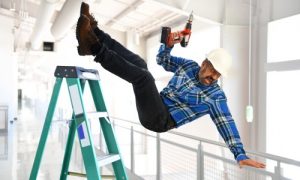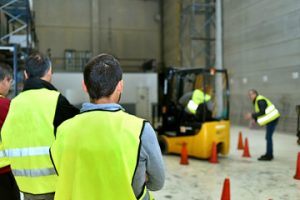Falls are a frequent cause of serious injury or death in Cambodian workplaces. Most of these incidents could of been avoided if correct safety measures had been in place.
With most of the injuries and deaths occurring on construction sites in Cambodia, it’s important that you take working at heights seriously and ensure you and your staff are following the correct safety measures for fall prevention?
Is Your Equipment Safe?
There is a variety of safety equipment available to assist and protect you when working in high places.
Equipment designed to assist you in reaching high places are often the cause of working at heights injuries and deaths due to poor quality, being damaged or used in a way that is not designed for the equipment. Equipment like ladders must be of good quality and have recognised safety ratings; ladder steps must be checked regularly and have non-slip treads.
 Scaffolding, which is used on nearly every construction site in Cambodia is often of poor quality, made from non-safety rated material and not able to support the weight of workers and equipment.
Scaffolding, which is used on nearly every construction site in Cambodia is often of poor quality, made from non-safety rated material and not able to support the weight of workers and equipment.
Using scaffolding netting, which is setup around the scaffolding at varying heights not only stops equipment and materials from falling down onto unsuspecting workers but can help prevent serious injury or death in the event of a fall from a height.
Lifts and platforms are regularly used in the workplace. Lifts should always be inspected prior to use to ensure they are in good working order. Like scaffolding, platforms should be well constructed, able to bear the weight of a person and equipment and be constructed by a reputable brand and to a recognised safety rating.
In all situations, if you are working at height, you must use a quality safety harness, with safety clips and lines attached to a solid fixed point; there should be no frays or shredded areas on the harness or lines.
Falling Items
Another important consideration when working at height is stopping equipment from falling from above. A screwdriver, hammer, paint bucket or any tool dropped from above will seriously injure or kill someone if it hits somebody’s head below. Safety tool lanyards are an important piece of safety equipment that can stop your tools from falling down below.
Safety nets that are setup around the area of a construction site are crucial in stopping tools, materials and debris from falling down on un-suspecting workers and visitors.
And without exception, every person on a worksite where there is construction or workers are operating machinery above head level, must wear a Hard Hat at all times. However, not just any hard hat will do; only Hard Hats that have been manufactured and certified by a reputable manufacturer, have been independently tested and are guaranteed to provide the level of protection required, should be used.
Regulations and Training
It’s not enough to simply provide equipment to workers, or have equipment checked regularly and think that you have provided a safe environment for your employees.
 Many serious injuries and deaths on worksites have occurred even when the person who was injured or killed was using quality safety equipment. And how is that possible you may ask? Well, their is a difference between wearing and using safety equipment and wearing and using safety equipment correctly. Many injuries and deaths have occurred because people did not understand or follow safety regulations and procedures on site and/or because people did not know how to use equipment correctly.
Many serious injuries and deaths on worksites have occurred even when the person who was injured or killed was using quality safety equipment. And how is that possible you may ask? Well, their is a difference between wearing and using safety equipment and wearing and using safety equipment correctly. Many injuries and deaths have occurred because people did not understand or follow safety regulations and procedures on site and/or because people did not know how to use equipment correctly.
It is imperative that all employees and worksites implement safety policies and procedures for their worksite and provide adequate training sessions for every person who enters their worksite so that safety policies and procedures are clearly understood. Whether it be a safety induction for new workers or visitors to a worksite, or regular training sessions for employees, the most dangerous aspect for a person on a worksite is not knowing or understanding what they cant and cant do with regards to safety.
Further to this, providing quality training on how to use equipment safely, particularly specialised equipment and machinery, is crucial. machinery being operated by someone who is not knowledgable or competent is a recipe for disaster.
Taking Safety Seriously
The core of being safe whilst working at height is taking safety seriously. If employers, employees and any person who enters a worksite does treat safety as a serious concern, then the chances of a serious injury or death is greatly increased. Implementing stringent safety policies & procedures, using quality safety equipment and providing adequate safety training may seem time consuming, costly and time consuming but the cost to you but is it worth risking your life or the life or your employees over?
Think Safe. Act Safe and Go Home Safe